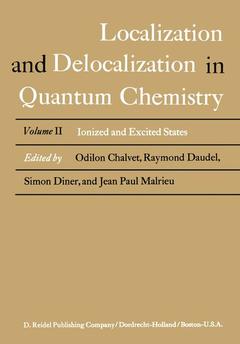I / Electron Localization in Ionized and Excited States.- Applications of Pair Density Analysis.- Localization and Local Phenomena in Molecular Excited and Ionized Stationary States.- Ionization and Localization.- II / Electron Localization as a Starting Point to Calculate Wave Functions.- The Reality of Some Bond Properties Additive Systems: Faraday Effect and Bond Magnetic Rotations.- The Localisability of Electrons as a Starting Point to Build Electronic Wave Functions.- On the Calculation of Wave Functions in the Theory of Loges.- Effective Molecular Hamiltonians, Pseudopotentials and Molecular Applications.- The Calculation of Intermolecular Interaction Energies in Terms of Local Contributions.- Localization, Bonds, and Physical Models of Molecular Reality.- How Does the PCILO Method Take Advantage of Localization?.- III / Excitons and Localization.- Excitons and Electronic Collective Excitations in Molecular Organic Solids.- Electronic Collective Excitations in Molecular One-Dimensional Systems. I: Optical Response, Localization and Motion of Linear Excitons.- Electronic Collective Excitations in One-Dimensional Molecular Systems. II: Motional Effects and EPR Response of Linear Triplet Excitons.- Motion of Localized Excitations in Organic Solids.- The Coupled Coherent and Incoherent Motion of Frenkel Excitons in Molecular Crystals.- Comments on Excitons and Localization.- Localized Excitons in a Fluorobenzene Crystal.- IV / Electron Localization and Chemical Reactivity.- ‘Spin Dependence’ of the Chemistry of Open-Shell Reactants.- Localized Analysis of the Stereospecificity of Concerted Reactions.- Molecular Valence States and Binding Energies.- Application of the Method of Group Density Analysis to a Study of Excited States Acid-Base Equilibria in ConjugatedMolecules.- Loge Theory and Chemical Reactivity.- Final Discussion.- Statistical and Stochastic Aspects of the Delocalization Problem in Quantum Mechanics.- Discussion of Claverie and Diner’s Paper: the Classical Limit in the Framework of Stochastic Mechanics.- Static and Dynamical Aspects of Delocalization. Electrons and Orbitals.- Index of Names.- Index of Subjects.




